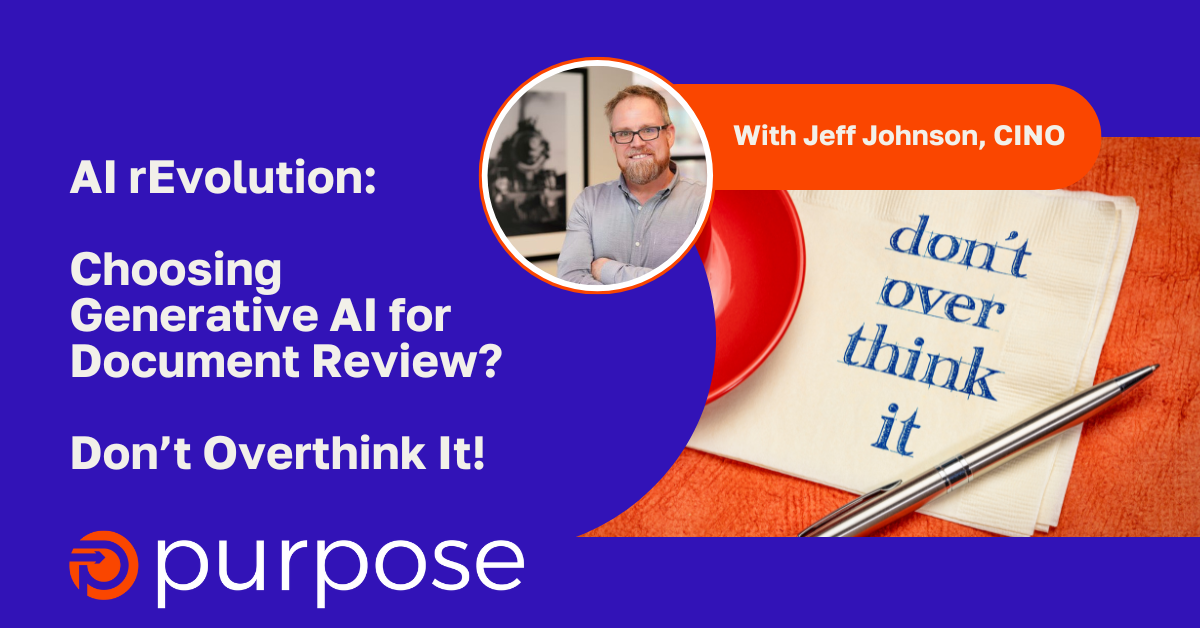By: Jeff Johnson, Chief Innovation Officer
Recently, while preparing for an upcoming panel presentation at the ASU Arkfeld eDiscovery, Law and Technology Conference on March 11 and 12 (Learn more about the conference HERE), my co-panelists and I were discussing GenAI-enabled eDiscovery document review automation. I suggested that these tools, from the various providers offering them today, are basically the same. My brilliant colleagues were quick to push back on that claim. I appreciated their perspective and left knowing they are correct AND so am I.
Of course, the tools are not the same. They may not use the same Large Language Model (LLM), they each have their “secret sauce” for LLM prompting, their various user interfaces (UI) do not have the same polish, their results won’t be strictly the same, and they are priced differently, too.
My advice? None of those factors are the most important in choosing a GenAI document review solution to try. Rather, you should test the one to which you can most readily obtain access and expert support. Period.
Allow me to explain that a little further.
The Pace of Change
We have entered a period of constant and rapid change for AI in legal solutions. The LLM best suited for eDiscovery review today may or may not be the best 6 months from now. The best supporting algorithms, UI and pricing today may or may not be the best in a matter of months.
Pick a solution that is available within an eDiscovery platform you are already using and familiar with.
Process Similarity Across Technologies
Across the widely available Generative AI-enabled eDiscovery document review solutions, the workflow development and delivery are strikingly similar. You identify your review set, develop prompting, validate prompting, and apply validated prompting to your review set. The application of these steps varies more for a specific use case than for specific technology.
Regardless of the tool you start with, defining success, an effective workflow, and an appropriate validation methodology are paramount.
Impressive Results Are Likely
Over a decade ago, my team and I built proprietary AI predictive coding technology. We obtained patents and approaches that made it, in our not-so-humble opinions, the best available.
Even so, using our technology was not always possible or practical. In those instances, we knew and repeatedly proved that we could, with a little extra work and guidance, achieve generally comparable results using other widely available tools. That principle remains just as true, if not more so, relative to the use of GenAI in eDiscovery document review.
Pick a solution for which you can readily receive, from your team, technology partner, or service provider, trusted expert consultation and support. The “Human Intelligence” contribution to this work makes a material difference in combination with proven GenAI technology.
Getting Started is of Pre-eminent Importance
Familiarity with the process and results from any reputable GenAI-enabled eDiscovery tool gives you a solid foundation that pays dividends.
Once you have experienced a tool first-hand, you are better able to compare and contrast that tool with the claims and performance of others.
Perhaps more importantly, you’ll be better prepared to use new and rapidly evolving tools in the months and years ahead.
Data Protection Disclaimer
Don’t forget data protection. Involve the experts and get all of the necessary approvals from your client, info sec and compliance teams. This is another aspect that may be made simpler and less time-consuming by selecting tools within the approved eDiscovery solutions you already use.
Conclusion
Don’t let a search for “the best AI in eDiscovery document review” delay your progress. Start with a technology you can access readily and for which you can get expert support. Recognize that as you learn and as the AI available rapidly changes, you will have opportunities to make different, learned selections in the future.
See all of our AI-related content here: https://www.purposelegal.io/embracingai/



